The Battle of Glieres
A fight for honour - Haute-Savoie, France, January 31 - March 26, 1944
Click here for the French original version
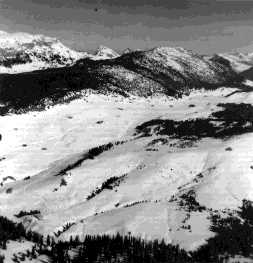
|
| Plateau of Glieres
|
"A fighter with a bee in his breeches is evidently not at his best."
On the 11th of November 1942, the Germans invaded the unoccupied zone in France to prevent the Allies from landing on the Mediterranean coastline. On the 27th of November, the French army allowed by the Armistice (100,000 men) was disarmed and dissolved. The Vichy government ordered the commanding officers of every unit to surrender their hidden arms to the Axis powers. Contrary to most of his colleagues, Vallette d'Osia, commander-in-chief of the 27th chasseurs alpins battalion (mountain light infantry) in Annecy (Haute-Savoie), refused to comply and went underground where he set up the local Armée secrète (underground army).
At that time, Germany was badly in need of manpower to replace all its mobilized workers. For this reason, the Germans pushed the Vichy government into establishing a forced labor draft in France : the STO (Service du travail obligatoire). On the 16th of February 1943, three annual contingents of recruits were called up to work in Germany. From the beginning of April, thousands of young men refused to leave and went into hiding. Many of them went to the mountainous wooded region of Savoie in the French Alps. The organized groups of the French Resistance in southern France - the United Movements of Resistance and the communist National Front - strove to regroup all these rebels in camps where they made every effort to give them military training, but only a minority agreed to fight. Nevertheless, the Maquis multiplied during the summer of 1943 even though they were hunted by the Italian troops or the Vichy police and were in short supply and little supported by the Allies or the Free French. Such a spontaneous movement was obviously underestimated. In spite of this, by the fall, they had begun guerrilla warfare targeting the collaborationist French Militia. As very few French army officers joined the Maquis, training centers were founded in the underground army. Because senior officer Vallette d'Osia was arrested in September, Colonel Romans-Petit, Regional commander of the Armée secrète in Ain, took command of the AS in Haute-Savoie and created a training center in the Bornes range near the plateau of Glières. In order to harass the enemy at the time of the expected Allied assault, the underground army badly needed arms. Most hidden arms depots were discovered by the occupying power itself or through denunciation. So, to find good dropping zones to supply the Maquis with arms and sabotage equipment, a mission was sent from London to the region of Savoie. Composed of Lieutenant-Colonel Heslop from the Special Operations Executive and Captain Rosenthal from the Free French Forces, this mission had first of all to investigate the capabilities of the Maquis and thrust itself with difficulty on an already well organized Resistance.
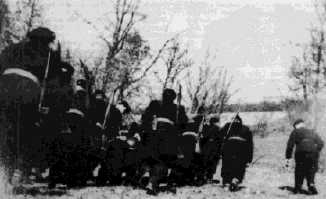
|
| The French Militia at Glieres
|
Six dropping zones were inspected and the plateau of Glières was chosen as the best one. This high remote mountain table in line with Lake Annecy was indeed ideal to drop supplies and even parachute troops after the Allied landing. Col. Romans-Petit put Lieutenant Tom Morel in charge of the Maquis. Former instructor at the St. Cyr Military College, Tom Morel was a smart, dynamic and audacious officer who was awarded the Cross of the Legion of Honour at twenty-four on the battle front of the Alps in 1940. He was commissioned to collect parachute drops from the Royal Air Force with a hundred men, and not at all to build a stronghold to be defended to the last man. On the 6th of February 1944, Col. Romans-Petit had to return to Ain where his Maquis were attacked by the Germans ; he gave the command of Haute-Savoie to Major Clair assisted by Capt. Rosenthal as a liaison officer with London. Two days later, Capt. Rosenthal, the Free French representative, convinced the other staff members to regroup the majority of maquisards on the plateau of Glières in order to establish a base to attack the Germans and carry out sabotage. Because the Allies were in doubt about the value of the French Resistance, it appeared to be necessary to show its capabilities to undermine the German military power in France on a large scale.
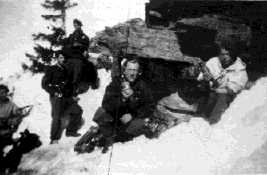
|
| French Maquisards
|
On the 31th of January 1944, the state of siege was declared in Haute-Savoie. Anyone found carrying arms or assisting the Maquis was subject to immediate court martial and execution. Hunted by the Vichy police and badly supplied, most of maquisards gathered on the plateau of Glières to set up the base of operations as planned. Soon after, a hundred French communist resistants and about fifty Spanish lumberjacks joined forces with them in taking refuge and getting weapons. Lt. Tom Morel welcomed all the volunteers and did not spurn the communist fighters just as the Vichy government tried to divide the Resistance against itself. From the 13th of February on, the four hundred and fifty maquisards, under the command of officers from the 27th chasseurs alpins battalion, were besieged by two thousand French militiamen and police. Although they suffered from starvation and frigid conditions, they collected three parachute drops consisting of about three hundred containers packed with small arms (Sten submachine guns, Enfield rifles, Bren light machine guns, Mills grenades) and explosives. The Maquis' major handicap for military action was its lack of heavy weapons : the plateau of Glières battalion had only several old machine guns and two 81 mm light mortars.
After a bloody skirmish with the Vichy forces, an agreement had been reached by which both sides would remain temporarily neutral. Nevertheless, five maquisards were taken prisoner by the Vichy police. Lt. Tom Morel became indignant at such treachery and decided to take hostages. On the night of the 9th and the 10th of March 1944, one hundred and fifty maquisards surrounded the village of Entremont and captured sixty Vichy GMR (police specially trained to fight against the Resistance), but their revered commander-in-chief, Lt. Tom Morel, was traitorously killed.
The Vichy government agreed that the Germans would step in if the Vichy forces had not quickly reduced the open rebellion at Glières. On the 12th of March 1944, after the largest Allied parachute drop, the Germans started to bomb the area with ground attack aircraft. The GMR, then the French Militia staged several attacks, but they ended in failure. On the 23th of March, three battalions from the 157th Reserve Division of Wehrmacht and two German police battalions, composed of more than four thousand with heavy machine guns, 80 mm mortars, 75 mm mountain guns, 150 mm howitzers and armoured cars, arrived in Haute-Savoie.
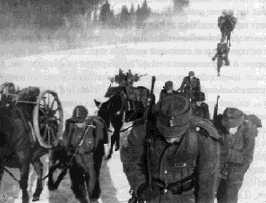
|
| German soldiers at Glieres
|
Reason told the new commander-in-chief, Captain Anjot (assistant to Vallette d'Osia, then to Clair), and the maquisards to withdraw while they still had time. Reason but not honour. With a verbal duel for several weeks between two talented radio announcers - one for the BBC and the other for Radio Paris - word had seeped out of France, Britain and America that a great and glorious uprising had taken place in southeast France. Clearly, Glières had become an important element in the psychological warfare. To honour the French Resistance, Capt. Anjot, an experienced, thoughtful and impassive officer, would fight in the face of defeat, but his aim was to save most of his men's lives.
Finally, on the 26th of March 1944, after another air raid and shelling, the Germans took the offensive. They split their attacking parties into three Kampfgruppen and designated to each one specific target. Reconnaissance was carried out by ski patrols dressed in white camouflage. One of the patrols and a Gebirgsjäger company made an attack on the main exit to the plateau and captured an advanced post in the rear. Sustaining the attack from one hundred and fifty German soldiers, eighteen maquisards fought and resisted into the night, but were outnumbered and overwhelmed (See Roger Cerri's story). At ten o'clock, Capt. Anjot thought honour had been satisfied and ordered the Glières battalion to retreat. In the days that followed, Capt. Anjot and almost all his officers as well as one hundred and fifty maquisards were found dead. They had been killed in battle or, if taken prisoner, had been tortured, shot or deported. For the Germans, the maquisards were not regulars but terrorists.
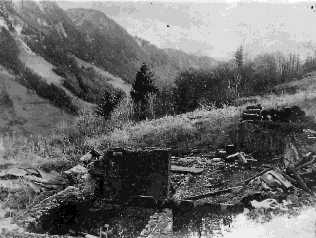
|
| Ruined chalet
|
The region of Savoie had been absolutely shattered. But this defeat would be transformed into a moral victory and give a boost to the French Resistance. Before the Allied landings in June 1944, the French Resistance, developed into a strategic weapon, informed the Allies on the German defense, directed sabotage against war industries, supply depots, railroads, telecommunications, and deleted enemy road movements through guerrilla action. After the landings, the underground army of FFI (French Forces of the Interior), numbering about 200,000 men, was able to engage some German forces and to free some parts of the French territory... It is a mark of the Maquis' success in Savoie that the speed of the American advance and the rapid retreat of the Germans was far beyond the expectations of Allied planning staff. The French Forces of the Interior had "impressed Allied leaders as having made a substantial contribution to the defeat of the enemy".
Contributed by Alain Cerri
|

